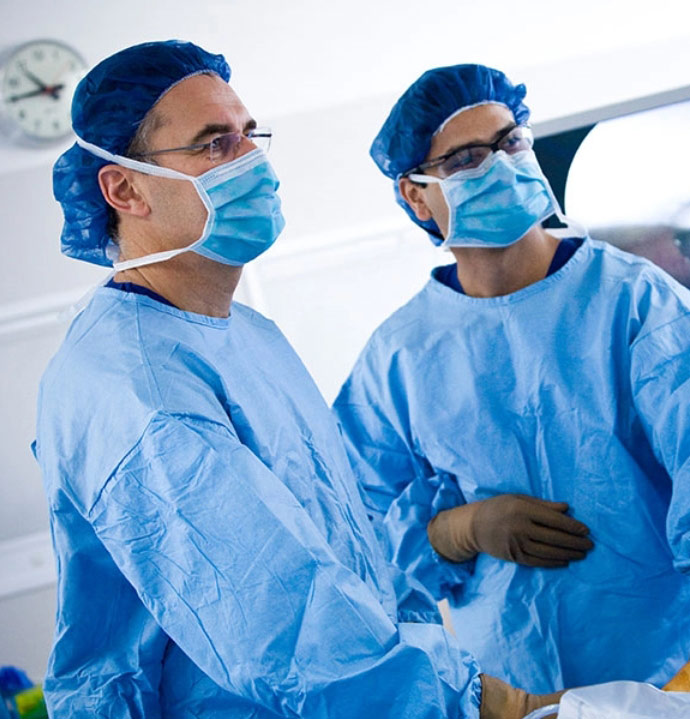
This is a major project that is looking at three specific outcomes following anterior cruciate ligament reconstruction; return to sport, further injury to either knee, and early detection of subsequent osteoarthritis.
In this project, we are working together with Professor Kate Webster from La Trobe University, our long time research associate and advisor, and prospectively documenting a range of demographic, physical, social, psychological, biochemical, genetic, hematological, and radiological factors in a large cohort of patients undergoing anterior cruciate ligament (ACL) reconstruction and to evaluate their influence on the three outcomes. The whole project is designed to involve 600 participants with a 10-year follow-up.
To our knowledge, our overall program is the first to prospectively evaluate such a large cohort of patients undergoing ACL reconstruction with such a diverse spectrum of clinically important baseline measures including, in particular, MRI based measurement of articular cartilage volume, long leg weight-bearing X-rays to measure limb alignment, biochemical, genetic and hematological variables, strength and balance, and precise biomechanical analysis of movement.
Balance and Function after ACL Reconstruction
Under the guidance of Dr. Ross Clark from Australian Catholic University, we have evaluated a large group of patients using the Wii balance platform to measure their balance one year after ACL reconstruction. We are using this data to see how balance relates to the overall function and return to sport.
Although knee replacement is a generally successful operation for pain relief, some patients describe limitations with specific, but common day-to-day activities. These include negotiating stairs, kneeling, and squatting. Continuing on from previous work using three-dimensional motion analysis, which was undertaken with Associate Professor Jodie McClelland at La Trobe University – we are currently assessing a larger cohort of patients with measures of strength, balance, and stair climbing ability. The results of this project will potentially allow for the development of specific rehabilitation interventions that will improve patients’ higher-level function after this increasingly common surgery.
BrainGYM: Get Ready to Play
The aim of this project, which is being undertaken with Dr. Clare Ardern (La Trobe University), is to investigate whether a web-based toolkit that specifically addresses psychological factors is effective in facilitating a return to the pre-injury level sport following ACL reconstruction. This new approach to rehabilitation represents a change from the traditional impairment-focused paradigm of post-operative rehabilitation to a more holistic and multidisciplinary approach, delivered in a way that is of low cost and high accessibility to everyday athletes.
The surgeons at OrthoSport Victoria have undertaken routine follow-up of patients undergoing specific surgical procedures over many years and now have large sets of data that allow for rigorous assessment of the outcomes of our surgery. This in turn helps us improve our techniques and approaches to specific problems.
The follow-up is in the form of pre-operative questionnaires, data from the operation itself, and subsequent follow-up by a combination of clinical examination and questionnaires. In recent years we have moved to online questionnaires, which make it much simpler for patients to participate. Data is not used without patients’ permission and is all de-identified for analysis. If you are asked to participate, we would be very grateful if you could find the time to complete the relevant questionnaire, usually no more than 15 minutes. It is important that we have information from as close to all patients as possible. Even if you are not happy with the outcome of your surgery, it is just as important to participate so that we can better understand how to improve the outcomes for future patients.
Currently, this type of follow-up is undertaken for anterior cruciate ligament reconstruction, knee replacement surgery, patellar stabilisation surgery, and osteotomy for knee osteoarthritis. We are currently expanding the follow-up to include shoulder stabilisation and rotator cuff repair, hand and wrist surgery, ankle reconstruction and replacement, and corrective osteotomies for foot and toe deformities.
OrthoSport Victoria extensively investigated the differences between the two common graft types used for anterior cruciate ligament (ACL) reconstruction: patellar tendon and hamstring tendon.
OrthoSport Victoria’s landmark randomised trial comparing patellar tendon and hamstring tendon is one of the most frequently cited studies and resulted in a move from patellar tendon to hamstring tendon reconstruction.
In a major study on the biomechanics of the knee following a total knee replacement (TKR), OrthoSport Victoria demonstrated the underlying causes of previously recognised but poorly understood functional limitations following this surgery.
This work has provided a springboard for the development of rehabilitation protocols that will potentially make significant improvements to the way people function following TKR, improving their ability to live independent lives.
OrthoSport Victoria published a study describing a new intra-operative technique to improve appropriate fixation of wrist fractures. Complications associated with the operative management of these fractures have been increasing substantially during the past four-to-five years, however, it is hoped that this new technique will decrease such complications.
The intra-operative technique has been incorporated into standard teaching internationally and has also led to further studies that confirmed it as more reliable than the previously accepted standards.
OrthoSport Victoria compared the outcomes of two surgical techniques of anterior cruciate ligament (ACL) reconstruction: double-bundle and the traditional single bundle.
Despite considerable enthusiasm for the double technique, our results revealed a higher failure rate that made orthopaedic surgeons around the world aware of this potential downside.
OrthoSport Victoria was one of the first to recognise the problem and is frequently recognised in the international orthopaedic community for this contribution.
OrthoSport Victoria was the first to publish the independent results of a series of ankle replacements using a recently released prosthesis. Various problems were identified that are now also becoming recognised by other surgeons worldwide.
If you are looking to book an appointment, please call us on